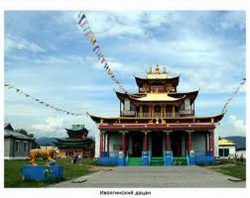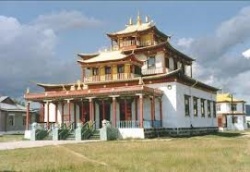Difference between revisions of "Ivolginsky datsan."
| Line 1: | Line 1: | ||
[[File:Ivolga tempel.jpg|thumb|250px|]] | [[File:Ivolga tempel.jpg|thumb|250px|]] | ||
| − | A [[Datsan]] refers to a [[Buddhist]] {{Wiki|university}} and [[Monastery]] in [[The Gelug Tradition]] of [[Tibetan Buddhism]]. [[Datsan]]'s are found in [[Mongolia]], a country tightly wound into the [[History of Tibetan Buddhism]]'s development, as well as in Siberia. | + | A [[Datsan]] refers to a [[Buddhist]] {{Wiki|university}} and [[Monastery]] in [[The Gelug Tradition]] of [[Tibetan Buddhism]]. [[Datsan]]'s are found in [[Mongolia]], a country tightly wound into the [[History of Tibetan Buddhism]]'s [[development]], as well as in {{Wiki|Siberia}}. |
[[File:Images01.874.jpg|thumb|250px|]] | [[File:Images01.874.jpg|thumb|250px|]] | ||
| − | [[Buryats]], an {{Wiki|ethnic}} minority group in Siberia, inhabit regions surrounding Lake Baikal and share many customs with the neighboring {{Wiki|Mongolians}}, including a popular and historic practice of [[Tibetan Buddhism]]. Since its inception in the mid 20th century, [[Ivolginsky Datsan]] has been a [[primary]] and {{Wiki|central}} node for practicing [[Buddhists]] in the region. More thorough historical research forthcoming on this historic site of The [[Dharma]]. | + | [[Buryats]], an {{Wiki|ethnic}} minority group in {{Wiki|Siberia}}, inhabit regions surrounding {{Wiki|Lake Baikal}} and share many customs with the neighboring {{Wiki|Mongolians}}, including a popular and historic [[practice]] of [[Tibetan Buddhism]]. Since its inception in the mid 20th century, [[Ivolginsky Datsan]] has been a [[primary]] and {{Wiki|central}} node for practicing [[Buddhists]] in the region. More thorough historical research forthcoming on this historic site of The [[Dharma]]. |
| − | As mentioned before, I had intended this blog as an exploration of [[Dharma]] centers in the [[United States]], with the [[lesser]] expressed (but present) intent of virtual travels to [[Tibet]] and [[India]] for historical and [[visual]] reference. [[Mongolia]] and Siberia necessarily become part of that equation as well, and while the core of postings may be U.S. related, I think it simply best to not limit the exploration from here on out. | + | As mentioned before, I had intended this blog as an exploration of [[Dharma]] centers in the [[United States]], with the [[lesser]] expressed (but {{Wiki|present}}) intent of virtual travels to [[Tibet]] and [[India]] for historical and [[visual]] reference. [[Mongolia]] and {{Wiki|Siberia}} necessarily become part of that equation as well, and while the core of postings may be [[U.S.]] related, I think it simply best to not limit the exploration from here on out. |
When I saw the above {{Wiki|image}} earlier today, I was thoroughly intrigued by the fusion of {{Wiki|Russian}} and [[Buddhist Architecture]], coupled with the [[traditional]] colorful display of [[Tibetan Buddhist]] aesthetics. Not to mention it was my first {{Wiki|learning}} of the term [[Datsan]]. | When I saw the above {{Wiki|image}} earlier today, I was thoroughly intrigued by the fusion of {{Wiki|Russian}} and [[Buddhist Architecture]], coupled with the [[traditional]] colorful display of [[Tibetan Buddhist]] aesthetics. Not to mention it was my first {{Wiki|learning}} of the term [[Datsan]]. | ||
Latest revision as of 22:39, 8 March 2015
A Datsan refers to a Buddhist university and Monastery in The Gelug Tradition of Tibetan Buddhism. Datsan's are found in Mongolia, a country tightly wound into the History of Tibetan Buddhism's development, as well as in Siberia.
Buryats, an ethnic minority group in Siberia, inhabit regions surrounding Lake Baikal and share many customs with the neighboring Mongolians, including a popular and historic practice of Tibetan Buddhism. Since its inception in the mid 20th century, Ivolginsky Datsan has been a primary and central node for practicing Buddhists in the region. More thorough historical research forthcoming on this historic site of The Dharma.
As mentioned before, I had intended this blog as an exploration of Dharma centers in the United States, with the lesser expressed (but present) intent of virtual travels to Tibet and India for historical and visual reference. Mongolia and Siberia necessarily become part of that equation as well, and while the core of postings may be U.S. related, I think it simply best to not limit the exploration from here on out.
When I saw the above image earlier today, I was thoroughly intrigued by the fusion of Russian and Buddhist Architecture, coupled with the traditional colorful display of Tibetan Buddhist aesthetics. Not to mention it was my first learning of the term Datsan.
Posted by Annika Lundkvist

